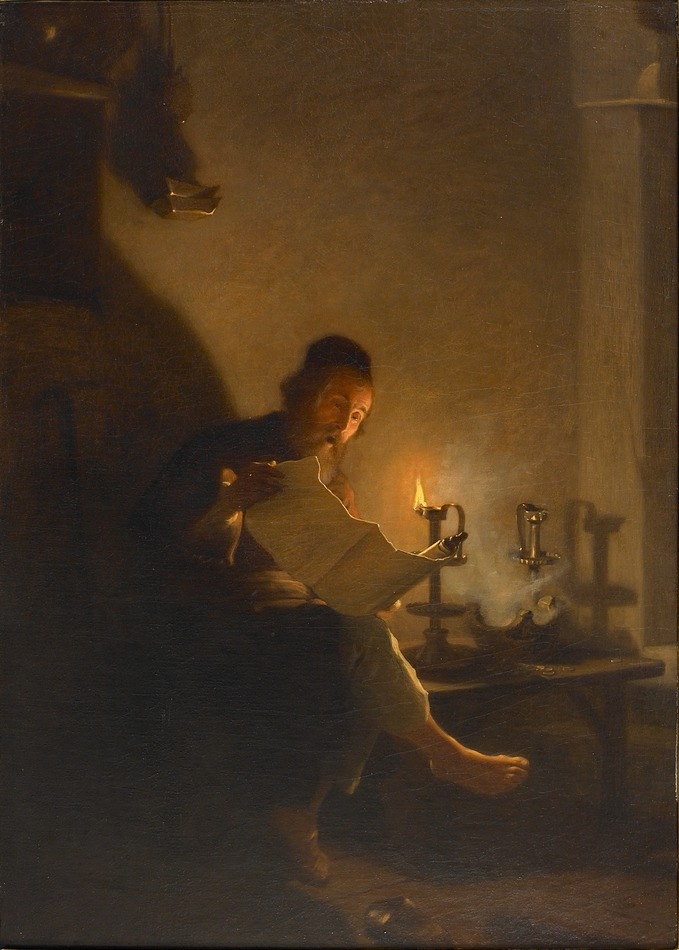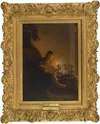Car Mardochée, le second après le roi (Mordecai, second in power to the king )
Signed and dated lower right: Lecomte du Nouy 1892
Provenance:
Private Collection, NY
The present work depicts Mordecai, from the Book of Esther. Mordecai was the adoptive father of Esther, the beautiful Jewess who became queen to the king Ahasuerus. Mordecai held an office in the king's court. After Esther was chosen as queen, he exposed a plot to assassinate the king. Later, Haman the Agagite was appointed to the highest position in the kingdom, but Mordecai refused to bow to him. Haman became so infuriated that he devised a plan to destroy not only Mordecai, but all of the Judeans in the empire. The king was unaware of the nationality of his beloved queen and gave Haman the authority to execute his plan. Haman had letters sent to every governor of every province that on a certain day they would coordinate the total annihilation of every Judean man, woman and child. Mordecai learned of this evil plan and notified Esther of Haman’s plot. Esther revealed the plot to the king and Haman was hanged and the plot stopped.
The subject is unusual for Lecomte du Noüy, who is primarily known for his Orientalist subjects. Although he exhibited religious and historical paintings at the Salon beginning in 1863, after 1872 when Lecomte du Noüy made an extended trip to Greece, Egypt, Turkey and Asia Minor, Orientalist themes dominated his oeuvre. Even among his religious compositions, Jewish themes were rare. He did complete an image of Judith (1875, Dahesh Museum of Art), depicting the profile of a woman in exotic dress and the traditional head-dress worn by married women from Bethlehem, as well as a composition Rabbis Commenting on the Bible on Saturday (1882, London, Guildhall Art Gallery). Additionally, Lecomte du Noüy’s first wife was the grand-daughter of Adolphe Crémieux, the former French Minister of Justice who withdrew from political office to become president of the Alliance Israélite Universelle in the 1860s. Lecomte du Noüy painted a portrait of Crémieux (1878), now at the Musée d’art et d’histoire du Judaïsme in Paris.
Jean Jules Antoine Lecomte du Noüy came from a noble Piedmontese family, living in France. He entered into the studio of Gleyre in 1861 at the age of 19, and later entered into the studio of Gérome, where he was a favorite student. In 1872, he won a second-prize Prix de Rome. Lecomte du Noüy was attracted to subjects from antiquity, and upon completion of his studies he travelled to Greece, Egypt, Turkey, and Asia Minor, making exacting archeological studies. From this time onward, he focused his oeuvre on Orientalist scenes and subjects. He won a second-class medal at the Salon of 1872, a medal in Vienna in 1873, and a gold medal at the Exposition Universelle of 1889. He was decorated with the Legion of Honor in 1876. In addition to his Orientalist paintings, Lecomte du Noüy also completed numerous portraits and sculptures, much like his mentor Gérome.
Selected Museum Collections:
Musée d?Orsay and Musée d?art et d?histoire du Judaïsme, Paris; Cleveland Museum of Art; Musée de Grenoble; Musée des Beaux-Arts de Lille; Musée des Beaux-Arts de Nantes; Dahesh Museum of Art, New York; Musée national des chateaus de Malmaison et de Bois-Préau, Reuil-Malmaison; Musée Lambinet, Versailles; Musée départemental de l?Oise, Beauvais;
Request more information
News on the artist
-
Lost work by J. L. Gerome discovered at Frankfurt's Stadel Museum: http://t.co/vcx9d1X #Gerome #Academic #OrientalismSeptember 9, 2011 @ 4:14 PM UTC
-
The Morgan Library & Museum presents seventeen master drawings by Ingres: http://t.co/TfECboP via @AddThis #AcademicSeptember 12, 2011 @ 8:29 PM UTC
-
Hemingway liked #Cabanel #Cezanne #Manet at the Met: http://t.co/IF0ljzf2 #Academic #PostImpressionistSeptember 16, 2011 @ 3:28 PM UTC
-
Barye’s The?se?e combattant le Centaure Bie?nor returned to Ile Saint–Louis http://t.co/064m0nUe #Academic #BaryeSeptember 23, 2011 @ 4:26 PM UTC
-
Jules Breton's autobiography "The Life of an Artist" is available on GoogleBooks: http://t.co/bwugE8rZ #Breton #Academic #RealismSeptember 30, 2011 @ 3:11 PM UTC
-
Happy belated b-day Elizabeth Jane Gardner Bouguereau, Oct 4, 1837 http://t.co/TsPKNRuc #GardnerB #AcademicOctober 6, 2011 @ 5:39 PM UTC
-
ENORMOUS Eugène #Delacroix exhinition opens at CaixaForum Madrid: http://t.co/ZkKTS99a #Academic #Romanticism #Orientalism #exhibitionsOctober 19, 2011 @ 3:06 PM UTC
-
National Gallery of Art to reopen 19th-century French galleries in January: http://t.co/2HcCfSuF #Academic #PostImpressionist #BarbizonOctober 20, 2011 @ 9:17 PM UTC
-
Read this review of the new #Puvis-de-Chavannes catalogue raisonne on 19th-century art worldwide: http://t.co/HVOM48Oe #Academic #SymbolistOctober 27, 2011 @ 4:06 PM UTC
-
Masterpieces from the Musée d'Orsay on view in Asia: http://t.co/xNhXdBgT #Realism #Barbizon #Academic #Impressionism #exhibitionsNovember 1, 2011 @ 3:38 PM UTC
-
Scottish National Gallery acquires Baron #Regnault portrait of his son: http://t.co/u8BUds7H via @AddThis #Academic @NatGalleriesScoNovember 3, 2011 @ 4:08 PM UTC
-
Take a photo tour of @MuseeOrsay new Impressionist galleries: http://t.co/gmVlnx5n @artinfodotcom #Academic #Impressionism #BarbizonNovember 3, 2011 @ 4:34 PM UTC
-
Look at this beautiful #Monchablon painting at the Assemblée Nationale in Paris via @MuseeOrsay http://t.co/NGluUfqS #AcademicNovember 10, 2011 @ 6:16 PM UTC
-
Musee des Augustins acquires 3 new portraits by Benjamin #Constant http://t.co/euA38VoB #Academic #RealismNovember 22, 2011 @ 10:17 PM UTC
-
Can't wait to see the #Sorolla and the Glory of Spanish Dress #exhibition @qssiny. Look at the slideshow here http://t.co/Wp0fk62y #AcademicDecember 7, 2011 @ 10:13 PM UTC
-
After seeing #Sorolla at the Spanish Institute, what about #Zorn at @ScanHouse? http://t.co/aTsu475w #Academic #exhibitionsDecember 7, 2011 @ 10:28 PM UTC
-
Tonight @SVA_News Linda Nochlin is giving a talk #Gericault and #Goya and Images of Misery 7pm http://t.co/mNcOaBHz #Academic #RomanticismDecember 8, 2011 @ 6:13 PM UTC
-
#Manet painting under export ban while £28m is sought to keep it in UK- http://t.co/OkMNnaDk @guardian #Impressionism #AcademicDecember 9, 2011 @ 4:38 PM UTC
-
December 19, 2011 @ 5:26 PM UTC
-
Newly renovated and freshly installed 19th-Century French galleries reopen at National Gallery of Art: http://t.co/7Vr9qHv7 @ngadc #AcademicJanuary 30, 2012 @ 10:37 PM UTC
-
Would love to page through this Book #Delacroix #Boudin #Degas #Cross #Guillaumin #Marquet http://t.co/qgTKbm7j #Academic #PostImpressionistFebruary 1, 2012 @ 4:33 PM UTC
-
Exhibition at the National Gallery of Denmark adds a new chapter to the story of Hammershøi: http://t.co/v83cFEVM #Academic #exhibitionsFebruary 9, 2012 @ 6:08 PM UTC
-
Look at this gorgeous #VanBeers at the Museum of Fine Art in Antwerp http://t.co/jbQs9jx6 #Academic #museumsFebruary 15, 2012 @ 10:17 PM UTC
-
This sounds like a beautiful small show: Near Paris: The Watercolors of Léon #Bonvin @walters_museum http://t.co/n3dy9ikr #Realism #AcademicMarch 6, 2012 @ 7:31 PM UTC
-
Happy birthday to one of my personal favorites, Emile #Friant, April 16, 1863: http://t.co/4PRpMkXo #Academic #NaturalismApril 16, 2012 @ 4:56 PM UTC
-
Baroness Carmen Thyssen Bornemisza to sell "The Lock" by John #Constable at Christie's: http://t.co/qdMksw47 #Academic #BarbizonMay 30, 2012 @ 7:40 PM UTC
-
Look at this bit on us and The Curator's Eye : http://t.co/8IY2NrYo via @sharethis #Academic #Lefebvre @schiller_bodoJuly 17, 2012 @ 9:56 PM UTC
-
Happy Birthday William Adolphe #Bouguereau, November 30, 1825 : http://t.co/2q9lvRAH #Academic #SalonPaintingNovember 30, 2012 @ 4:30 PM UTC
-
The Petit Palais has a Felix #Ziem exhibition opening on Valentine's Day (2 good reasons to go to Paris!) http://t.co/5D8eW2xv #AcademicJanuary 28, 2013 @ 9:04 PM UTC
-
'Unbalanced' woman vandalises famed Eugene #Delacroix painting at the #Louvre in Lens http://t.co/sFEAYl9Y #Academic #MuseumNewsFebruary 11, 2013 @ 6:57 PM UTC
-
see Impressionism, Fashion, and Modernity @metmuseum and with #Saintin at Schiller & Bodo #constantcontact #Academic http://t.co/e5asUAweOzMay 17, 2013 @ 3:10 PM UTC
-
Indianapolis Museum of Art receives major painting by William-Adolphe #Bouguereau http://t.co/FWReLEbN7l #Academic #museumsMay 31, 2013 @ 3:55 PM UTC
-
A Finer École des Beaux-Arts, Thanks to Ralph Lauren | BLOUIN ARTINFO http://t.co/Ftz5IqCzqj #EcoledesBeauxArts #AcademicJuly 24, 2013 @ 3:16 PM UTC
-
Gustave Jean #Jacquet : Validating His Rightful Place in Art History | Literary & Visual Arts | Epoch Times http://t.co/kJC8sRDS0y #AcademicSeptember 10, 2013 @ 7:24 PM UTC
-
Happy Birthday to Elizabeth Jane #Gardner #Bouguereau, born this day in 1837! https://t.co/YMC2Df99b9 #AcademicOctober 4, 2013 @ 3:50 PM UTC
-
May 12, 2014 @ 2:27 PM UTC
-
A new take on #Bouguereau - Artist Imagines Classical Paintings as Part of Contemporary Life http://t.co/uirHm5cwmP via @Colossal #AcademicMay 26, 2015 @ 8:12 PM UTC
-
Major survey of portraits by #Winterhalter at the Museum of Fine Arts, Houston https://t.co/Je8sUZJvfT #Academic #exhibitionsIwishIcouldseeApril 19, 2016 @ 9:52 PM UTC
-
Happy Birthday, Elizabeth Gardner #Bouguereau, born October 4, 1837: https://t.co/vtuYr4dxqc #AcademicOctober 4, 2016 @ 8:04 PM UTC




